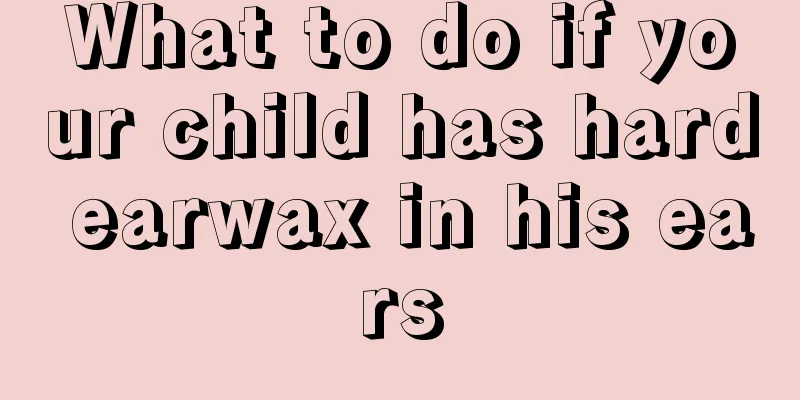What causes a child's stomach ache at night?

|
Stomachache is a common phenomenon in children. Due to unhygienic diet, some viruses and bacteria are often brought into the stomach and intestines. Generally, this symptom occurs at night. Children do not feel stomachache when playing during the day, but they will feel stomachache when they calm down at night. When the condition is mild, you can give the baby some warm water and use a hot pack to warm the baby's stomach to relieve stomach pain. Stomach ache is one of the most common symptoms in babies:Generally speaking, common causes of abdominal pain include intestinal cramps, ascariasis, dysentery, intussusception, appendicitis, etc. Because the causes of stomach pain in children are complex, a comprehensive assessment from multiple aspects is generally required to confirm the diagnosis. If parents understand the general causes and classifications of their baby's stomachache, they will not panic when facing their baby's stomachache. There are many kinds of abdominal pain. Usually, the general cause of abdominal pain can be understood according to the baby's age characteristics, degree and location of abdominal pain. Judging from their age, stomach pain in babies under one year old is mostly caused by intussusception. Babies around three years old are more likely to have intestinal cramps. Stomach pain in preschool children is mostly caused by intestinal roundworms or autonomic nervous system dysfunction. Determined by pain level Severe abdominal pain: lying still and not daring to move, mostly due to acute inflammation, such as acute appendicitis, acute cholecystitis, etc.; severe abdominal pain like colic, mostly due to ascariasis, urinary stones, etc.; tearing abdominal pain, common in visceral perforation, such as stomach and gallbladder perforation. Determined by the location of the pain Pain in the upper and middle abdomen is often caused by stomach problems; pain in the right upper abdomen is often caused by liver and gallbladder diseases; pain in the lower and middle abdomen is often caused by intestinal diseases; overall abdominal pain is often caused by organ perforation or necrosis or bleeding of diseased tissue; pain around the umbilicus is often caused by small intestine diseases; pain in the right lower abdomen is often caused by appendicitis. How to deal with it: Should you send your baby to the hospital or not? When it comes to the question of whether to send your baby to the hospital for stomachache, parents should take a cautious attitude. Because the hidden problems behind baby's stomach pain can be small or big, and if you don't pay attention, the disease will be delayed. Especially when the baby rolls on the ground in pain, or has any symptoms such as high fever, diarrhea or vomiting, he should be rushed to the hospital for diagnosis and treatment. Of course, some simple stomach pains may just be a false alarm. Even though some pains are quite severe and the baby keeps crying, the pain will disappear after being sent to the hospital. This is because the baby has intestinal spasm. Once the spasm is relieved, the pain is relieved immediately, so the baby starts jumping around again. But new parents can't distinguish the above situations.
It is safer to send him to the hospital. To apply or not to apply, some parents get a hot water bottle to apply heat to their children when they hear their children complaining of stomachache. This practice is effective for stomach bloating and pain caused by cold and overeating. It can relieve gastrointestinal cramps and reduce pain. But some pains are not so simple. Hot compresses may aggravate the condition and cause danger, such as ascariasis (which is also a common cause of stomach pain in babies). When certain factors stimulate the worm body, the roundworm can cause it to wriggle up and down, stimulating the intestines and causing more severe spasms and pain. At this time, massaging the baby's belly will only further stimulate the roundworms and even cause biliary ascariasis. The roundworms may also penetrate the delicate intestinal wall of young children and cause peritonitis. Whether to rub or not, the baby complains of stomachache. Mothers always like to rub the baby, thinking that it will definitely relieve the child's pain. This method has a certain effect on gastrointestinal colic caused by gastrointestinal spasm. However, you should not rub your belly casually in the following situations. Acute appendicitis is also more common in children. Children's appendicitis does not have typical symptoms in the early stages. They may have mild pain around the navel, sometimes vomiting and diarrhea, and the pain is not obvious when pressing the stomach. Children have weaker immune systems and are more likely to have appendicitis perforated. If parents massage the baby's belly or apply local hot compress at this time, it may promote rupture and perforation of the inflamed and suppurative area, forming diffuse peritonitis. Intussusception is more common in young children, especially those who are obese. Because the blood supply of the invaginated intestines is obstructed, it causes pain and necrosis over time. If you massage blindly, it may cause the insertion area to deepen and aggravate the condition. When your baby has a stomachache, parents should not be too nervous. If you feel you cannot solve the problem, the best way is to take the baby to the hospital as soon as possible. Perplexing, habitual abdominal painHabitual abdominal pain is a common type of pediatric abdominal pain that has not yet been included in general textbooks. When various possible acute diseases and ascariasis are excluded, all kinds of recurrent abdominal pains that cannot be found due to any cause may be habitual abdominal pain. The cause of this stomach pain is unclear. At present, there is no special treatment for habitual stomach pain. Parents should try their best to prevent constipation in their babies and give them more fruits, yogurt and other foods that are beneficial to gastrointestinal digestion. When the baby is in pain, parents can press the "Zusanli" point with their thumbs, which can quickly relieve the baby's pain. Be careful not to press with fingernails to avoid hurting the baby's delicate skin. The location of "Zusanli" is on the outside of the knee joint, one finger thick away. You can also let the child sit on a chair, bend the knee joint and press the right thumb on the right knee joint (you can also use the left hand to measure the left knee). The area where the middle finger is pressed on the outside of the knee joint is the Zusanli acupuncture point. This acupoint has a large upper and lower range, so it does not need to be very accurate. |
<<: What causes dizziness and stomachache in children?
>>: Symptoms of calcium deficiency in breastfed babies
Recommend
What is myocarditis in children?
Myocarditis is a common heart disease that is not...
What should I do if my baby is zinc deficient for more than three months?
Zinc is one of the essential trace elements in th...
What are the symptoms of appendicitis in children?
Children will always encounter problems of one ki...
What is the dietary treatment for hernia in children?
Every parent with a child will be very anxious wh...
What should children eat to nourish their kidneys?
Nowadays, children's development is becoming ...
Can children drink Cassia seeds?
Cassia seed is a traditional Chinese medicine. Ch...
Why do children grind their teeth at night?
Many children have some bad living habits, and so...
Dosage of Bupleurum injection for children
Chaihu Injection is a medicine used to treat feve...
How should ADHD in children be treated better?
Generally speaking, children are more active, but...
What to do if your baby wakes up coughing
Coughing is a very common symptom. We all know th...
Can young children eat pomegranates?
Pomegranate is a fruit that tastes sour and can h...
Treatment of red spots on newborn baby's eyelids
The birth of every new life will make our parents...
What is the normal body temperature for premature babies?
For newborns, due to different physical constitut...
Black spots in the eyes of children
The eyes are the windows to the soul. People'...
Baby's lower teeth cover the upper
Many parents find that their baby's teeth are...









